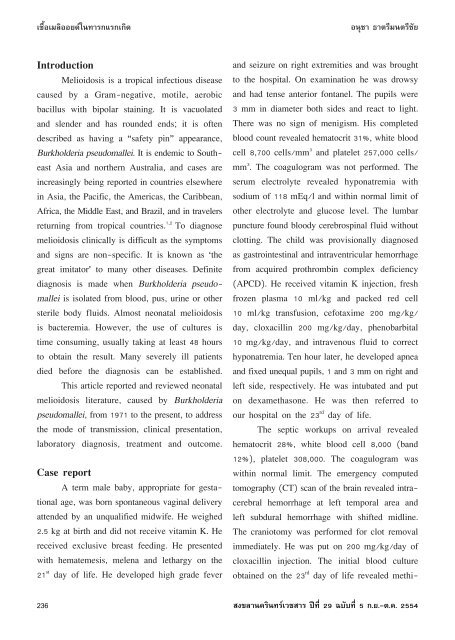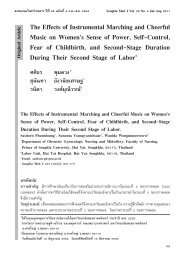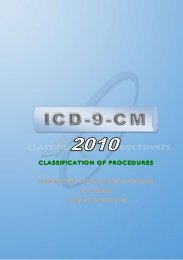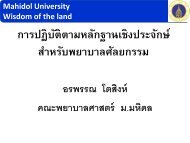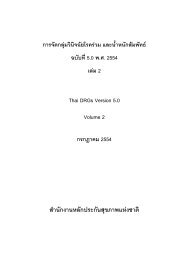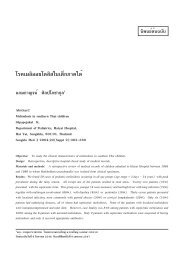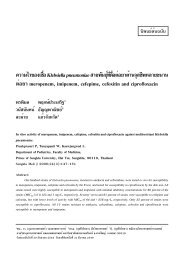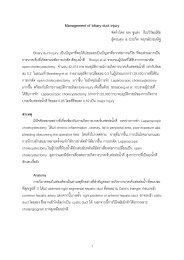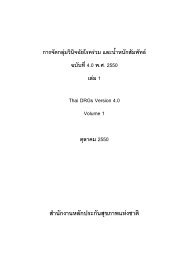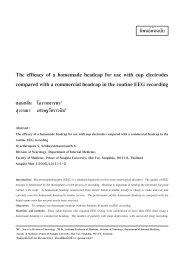A Case Report and Literature Review Anucha Thatrimontrichai ...
A Case Report and Literature Review Anucha Thatrimontrichai ...
A Case Report and Literature Review Anucha Thatrimontrichai ...
Create successful ePaper yourself
Turn your PDF publications into a flip-book with our unique Google optimized e-Paper software.
เชื้อเมลิออยด์ในทารกแรกเกิด อนุชา ธาตรีมนตรีชัย<br />
Introduction<br />
Melioidosis is a tropical infectious disease<br />
caused by a Gram-negative, motile, aerobic<br />
bacillus with bipolar staining. It is vacuolated<br />
<strong>and</strong> slender <strong>and</strong> has rounded ends; it is often<br />
described as having a “safety pin” appearance,<br />
Burkholderia pseudomallei. It is endemic to Southeast<br />
Asia <strong>and</strong> northern Australia, <strong>and</strong> cases are<br />
increasingly being reported in countries elsewhere<br />
in Asia, the Pacific, the Americas, the Caribbean,<br />
Africa, the Middle East, <strong>and</strong> Brazil, <strong>and</strong> in travelers<br />
returning from tropical countries. 1,2 To diagnose<br />
melioidosis clinically is difficult as the symptoms<br />
<strong>and</strong> signs are non-specific. It is known as ‘the<br />
great imitator’ to many other diseases. Definite<br />
diagnosis is made when Burkholderia pseudomallei<br />
is isolated from blood, pus, urine or other<br />
sterile body fluids. Almost neonatal melioidosis<br />
is bacteremia. However, the use of cultures is<br />
time consuming, usually taking at least 48 hours<br />
to obtain the result. Many severely ill patients<br />
died before the diagnosis can be established.<br />
This article reported <strong>and</strong> reviewed neonatal<br />
melioidosis literature, caused by Burkholderia<br />
pseudomallei, from 1971 to the present, to address<br />
the mode of transmission, clinical presentation,<br />
laboratory diagnosis, treatment <strong>and</strong> outcome.<br />
<strong>Case</strong> report<br />
A term male baby, appropriate for gestational<br />
age, was born spontaneous vaginal delivery<br />
attended by an unqualified midwife. He weighed<br />
2.5 kg at birth <strong>and</strong> did not receive vitamin K. He<br />
received exclusive breast feeding. He presented<br />
with hematemesis, melena <strong>and</strong> lethargy on the<br />
21 st day of life. He developed high grade fever<br />
236<br />
<strong>and</strong> seizure on right extremities <strong>and</strong> was brought<br />
to the hospital. On examination he was drowsy<br />
<strong>and</strong> had tense anterior fontanel. The pupils were<br />
3 mm in diameter both sides <strong>and</strong> react to light.<br />
There was no sign of menigism. His completed<br />
blood count revealed hematocrit 31%, white blood<br />
cell 8,700 cells/mm 3 <strong>and</strong> platelet 257,000 cells/<br />
mm 3 . The coagulogram was not performed. The<br />
serum electrolyte revealed hyponatremia with<br />
sodium of 118 mEq/l <strong>and</strong> within normal limit of<br />
other electrolyte <strong>and</strong> glucose level. The lumbar<br />
puncture found bloody cerebrospinal fluid without<br />
clotting. The child was provisionally diagnosed<br />
as gastrointestinal <strong>and</strong> intraventricular hemorrhage<br />
from acquired prothrombin complex deficiency<br />
(APCD). He received vitamin K injection, fresh<br />
frozen plasma 10 ml/kg <strong>and</strong> packed red cell<br />
10 ml/kg transfusion, cefotaxime 200 mg/kg/<br />
day, cloxacillin 200 mg/kg/day, phenobarbital<br />
10 mg/kg/day, <strong>and</strong> intravenous fluid to correct<br />
hyponatremia. Ten hour later, he developed apnea<br />
<strong>and</strong> fixed unequal pupils, 1 <strong>and</strong> 3 mm on right <strong>and</strong><br />
left side, respectively. He was intubated <strong>and</strong> put<br />
on dexamethasone. He was then referred to<br />
our hospital on the 23 rd day of life.<br />
The septic workups on arrival revealed<br />
hematocrit 28%, white blood cell 8,000 (b<strong>and</strong><br />
12%), platelet 308,000. The coagulogram was<br />
within normal limit. The emergency computed<br />
tomography (CT) scan of the brain revealed intracerebral<br />
hemorrhage at left temporal area <strong>and</strong><br />
left subdural hemorrhage with shifted midline.<br />
The craniotomy was performed for clot removal<br />
immediately. He was put on 200 mg/kg/day of<br />
cloxacillin injection. The initial blood culture<br />
obtained on the 23 rd day of life revealed methi-<br />
ส§¢ÅÒ¹¤ÃÔ¹·ร์àǪสÒà »‚·Õè 29 ©ºÑº·Õè 5 ก.ย.-ต.ค. 2554


